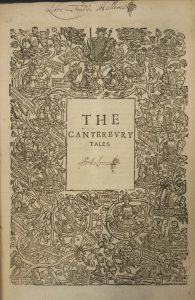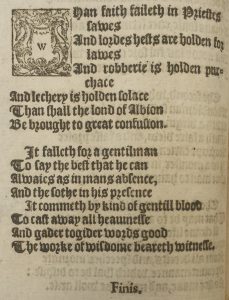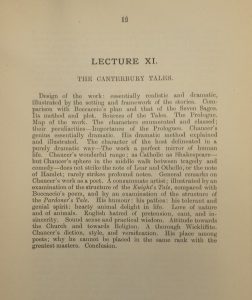August 23, 2019, by Kathryn Steenson
The Canterbury Tales
Geoffrey Chaucer (1340s – 25 October 1400) is widely considered the greatest English poet and author of the Middle Ages. He played a significant role in legitimising the use of the Middle English vernacular in literary works in an age when many authors in England wrote in French and Latin. He died in 1400 and in 1556 his remains were re-interred in a more elaborate tomb in what is now Poets’ Corner in Westminster Abbey.
Probably born in London into a family of vintners (winemakers), Chaucer had a varied and well-documented career as a courtier. He travelled widely around Europe with the royal court, and then as a civil servant, including Comptroller for the customs at the Port of London, and Clerk of the King’s Works, overseeing royal building and renovation projects. He authored or translated many literary works during this time, including his most famous work, The Canterbury Tales. It is a collection of 24 stories in verse and prose told by a fictional group of pilgrims as they travel to Saint Thomas Beckett’s shrine in Canterbury Cathedral. The characters and the tales they tell are diverse and represent cross-section of late medieval English society.

Illustration from The Ellesmere Chaucer: reproduced in facsimile (1911). Special Collection Over.X PR1865.F11 barcode SC100183
No copies of The Canterbury Tales survive from Chaucer’s lifetime. This beautiful image is from the 15th-century Ellesmere Manuscript, which was created within a decade or so after Chaucer’s death. It is one of the most significant copies of the poem, being both one of the earliest copies and the one that defined the order in which the tales were presented. This image of the Clerk of Oxford, drawn next to his tale, is taken from our facsimile copy that dates to 1911. The original was owned by the Barons (later Earls) of Ellesmere for several generations before being sold to the Huntingdon Library in California. One scribe and three illuminators created this copy, which includes 22 images of the pilgrims, often at the beginning of their tales, and, unusually for medieval literature, a portrait of the author Chaucer.

Frontispiece of The workes of our antient and lerned English poet, Geffrey Chaucer, newly printed (1598). Ref: Special Collection Oversize PR1850.B98 barcode 6002587503

Text from The workes of our antient and lerned English poet, Geffrey Chaucer, newly printed (1598). Ref: Special Collection Oversize PR1850.B98 barcode 6002587503
Two previous owners of this volume have written their names on this frontispiece, which is decorated with pictures of royalty and the nobility. Although we can’t condone writing in books, this is very useful in helping establish provenance of individual rare volumes. Early printed books often used a typeface that mimicked the older handwritten versions. The decorative initial letters and Blackletter style typeface used in this printed copy is very similar to the handwriting medieval scribes would have used for important works, and indicates both the status of Chaucer’s works and that of the purchaser . This ‘newly printed’ volume is now just over 400 years old and contains Chaucer’s original works, such as Troilus and Criseyde and The Canterbury Tales, and some poems he translated e.g. The Romaunt of the Rose. This volume also has a chapter explaining the old and obscure words Chaucer, which shows how much the English language had changed in 200 years. By contrast, modern readers have no difficulty reading works by Jane Austen and other early 19th century writers.

Printed pamphlet relating to the (London) University Extension Lectures syllabus of a course of lectures on Early English Literature from the origins to Chaucer (1888). Ref: Bd 70
Generations of school pupils and university students have studied Chaucer, most often his magnum opus The Canterbury Tales or its prologue. This course on ‘Early English Literature from Origins to Chaucer’ was a mix of history, linguistics and literature. Students were expected to be able to read Chaucer’s Middle English fluently, and were advised to have a basic grasp of the elements of Anglo-Saxon before beginning the course. Prior to gaining University status in 1947, students at University College Nottingham had their degrees awarded by the University of London, hence the London exam board. This pamphlet of the syllabus comes from the papers of Richard Warwick Bond (1857-1943) who was Chair of English at UCN from 1911 until his retirement in 1925.
These volumes of Chaucer, and several others we hold, be searched in our catalogue and viewed in the Reading Room at King’s Meadow Campus. We recommend that you email us to let us know when you’re coming and what you’d like to see. You can also follow us on Twitter @mssUniNott and read our newsletter Discover.
No comments yet, fill out a comment to be the first

Leave a Reply